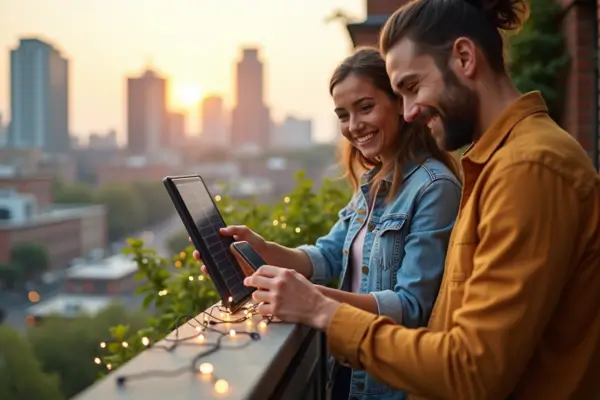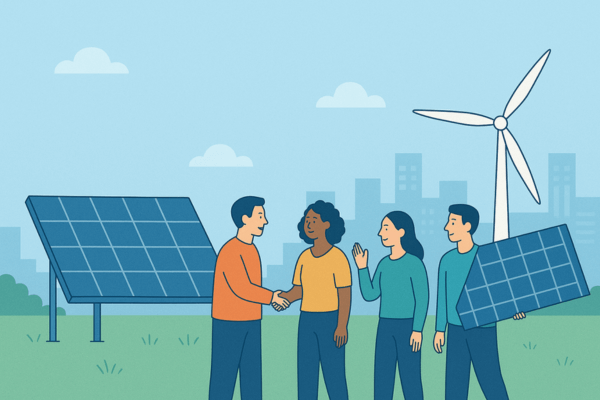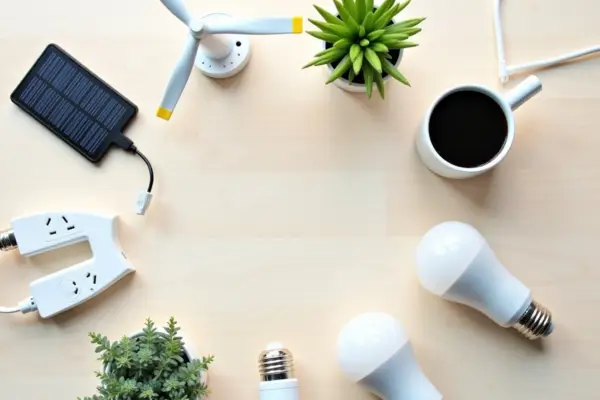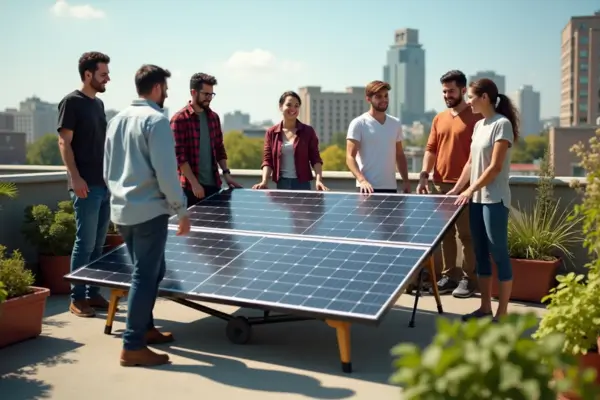As cities grow denser and environmental concerns become more urgent, the need for green energy solutions in urban areas has never been greater. Urban spaces contribute significantly to carbon emissions, but they also hold immense potential for sustainable energy adoption. From reducing reliance on fossil fuels to improving air quality, renewable energy can transform how cities function—even in the smallest of spaces.
However, implementing green energy in tight urban environments comes with challenges. Limited rooftop space, building restrictions, and high upfront costs can make it seem daunting. Many renters and apartment dwellers also face hurdles in installing traditional solar panels or wind turbines. Yet, with innovation and smart design, even the most compact urban spaces can harness clean energy effectively.
The benefits of adopting green energy solutions are undeniable:
- Cost savings – Lower electricity bills over time with solar, wind, or energy-efficient systems.
- Sustainability – Reduced dependence on non-renewable resources.
- Smaller carbon footprint – Contributing to cleaner air and a healthier planet.
In this article, we’ll explore five easy ways to integrate green energy into small urban spaces—proving that sustainability is possible, no matter how limited your square footage may be.

Solar Panels for Balconies and Small Rooftops
When people think of solar energy, they often picture vast rooftop arrays or sprawling solar farms. But what if you live in an apartment or have just a tiny balcony? Good news—compact solar solutions make it possible for urban dwellers to harness the sun’s power, even in tight spaces.
Compact Solar Panel Options for Urban Dwellers
Today’s market offers a variety of space-efficient solar solutions, including:
- Foldable solar panels – Portable and perfect for balconies; can be adjusted to catch optimal sunlight.
- Solar balcony kits – Plug-and-play systems that connect to your home’s power supply without major installation.
- Solar-powered chargers – Small panels for charging phones, laptops, or small appliances.
How to Install and Maximize Efficiency in Limited Spaces
You don’t need a huge roof to benefit from solar energy. Here’s how to make the most of your setup:
- Angle matters – Adjust panels to face the sun (south-facing in the Northern Hemisphere, north-facing in the Southern Hemisphere).
- Use vertical space – Mount panels on balcony railings or walls if floor space is limited.
- Avoid shading – Keep panels clear of obstructions like trees or neighboring buildings.
Cost-Effective and Portable Solar Solutions
Solar energy doesn’t have to break the bank. Many budget-friendly options allow you to start small and scale up:
- DIY solar kits – Affordable and easy to install for beginners.
- Community solar programs – If you can’t install panels, subscribe to a shared solar project.
- Government incentives – Check for tax credits or rebates that reduce upfront costs.
With these innovations, even renters and small-space dwellers can tap into solar power—cutting energy bills and reducing their carbon footprint one sunny day at a time.
Vertical Wind Turbines for Apartment Buildings
Harnessing Small-Scale Wind Energy in Urban Spaces
When we imagine wind turbines, massive horizontal-axis turbines in open fields often come to mind. But cities have their own wind patterns—channeled between buildings, across rooftops, and through urban corridors. Vertical-axis wind turbines (VAWTs) are specially designed to capture these unpredictable urban breezes, making wind energy a viable option even in dense cityscapes.
Why Vertical-Axis Wind Turbines Are Perfect for Cities
Unlike traditional wind turbines, VAWTs offer unique advantages for urban environments:
- Space-efficient design – Their compact, cylindrical shape allows installation on rooftops, balconies, or even building facades without requiring large open areas.
- Quiet operation – With no loud spinning blades, VAWTs won’t disturb you or your neighbors—ideal for residential areas.
- Omnidirectional efficiency – They catch wind from any direction, making them effective in cities where wind swirls unpredictably around structures.
Where to Place Your Turbine for Maximum Power
To get the most out of a small-scale wind turbine, strategic placement is key:
- Rooftop mounting – Elevating the turbine above obstructions increases wind exposure.
- Balcony or terrace installation – If rooftop access isn’t possible, a sturdy railing mount can still generate power.
- Avoiding “wind shadows” – Keep turbines clear of tall buildings or walls that block airflow.
- Combining with solar – Pairing a VAWT with solar panels creates a hybrid system for more consistent energy production.
A Practical Step Toward Urban Sustainability
While a single small turbine won’t power an entire apartment, it can significantly offset energy use—especially when combined with other green solutions. Modern VAWTs are becoming more affordable, with some models even featuring sleek designs that blend into urban architecture.
For city dwellers looking to diversify their renewable energy sources, vertical wind turbines offer a silent, space-smart way to turn every breeze into clean power.

Energy-Efficient LED Lighting and Smart Systems
Brighten Your Space While Shrinking Your Energy Bill
One of the easiest and most impactful ways to go green in urban spaces starts right above your head—with your lights. By upgrading to energy-efficient LED lighting and incorporating smart lighting systems, you can dramatically cut electricity usage without sacrificing comfort or style.
Why LED Bulbs Are a Game-Changer
Making the switch from traditional incandescent or CFL bulbs to LEDs delivers immediate benefits:
- 75-80% less energy used – LEDs consume far less power while providing the same brightness.
- 10-25x longer lifespan – Fewer replacements mean less waste and long-term savings.
- Cooler operation – Reduced heat output lowers AC costs in small spaces.
- Instant full brightness – No warm-up time like CFLs.
Pro tip: Look for bulbs with the ENERGY STAR label for optimal efficiency and quality.
Smart Lighting: The Next Level of Energy Savings
Take your efficiency further with intelligent lighting systems:
- Motion sensors – Lights automatically turn off when no one’s in the room (perfect for hallways or bathrooms).
- Smart timers/schedules – Program lights to match your daily routine (e.g., turning off at bedtime).
- Voice/app control – Adjust brightness or turn lights off remotely to prevent wasted energy.
- Adaptive brightness – Some systems automatically adjust based on natural light levels.
Small Changes, Big Impact
The collective effect of these upgrades is staggering:
- Replacing just 5 frequently used bulbs with LEDs can save about $75/year.
- Adding smart controls can reduce lighting energy use by an additional 30-50%.
- In apartments where space limits bigger renewable solutions, these tweaks offer meaningful carbon reduction.
Lighting the Way to a Greener Future
Unlike bulky solar panels or turbines, LED and smart lighting upgrades require no permits, no installation hassles, and provide instant savings—making them the perfect starting point for urban eco-warriors. When paired with other green energy solutions, these bright ideas help create truly sustainable small spaces.
Mini Hydropower Systems for Urban Water Sources
Turning Urban Water Flow into Clean Energy
While hydropower typically conjures images of massive dams, innovative micro-hydropower systems now allow city dwellers to harness energy from small water flows. Whether you have access to rainwater runoff, a small fountain, or even a balcony drainage system, these compact solutions can generate surprising amounts of electricity for urban spaces.
Urban Hydropower Opportunities
Several water sources can be tapped for micro-energy generation:
- Rainwater harvesting systems – Channel roof runoff through a small turbine
- Balcony drainage pipes – Vertical drops can spin micro-turbines
- Recirculating water features – Small garden fountains or artificial streams
- Building wastewater systems – Some high-rises are experimenting with turbine-equipped drains
Compact Hydropower Solutions for Small Spaces
Modern micro-hydropower options include:
- Pico hydro generators (under 5kW) – Small enough for balcony installation
- Waterwheel-style turbines – Decorative yet functional for garden streams
- Inline pipe turbines – Installed directly in downspouts or drainage pipes
Feasibility and Installation Considerations
Before installing a micro-hydropower system:
- Assess your water source – You’ll need at least 2-3 feet of vertical drop and consistent flow
- Check local regulations – Some areas restrict water diversion
- Calculate potential output – Most urban systems generate 100-500 watts (enough for lighting or small appliances)
- Consider hybrid systems – Pair with solar for more consistent generation
Making Every Drop Count
While urban hydropower won’t replace your grid connection, these systems:
- Provide clean backup power during outages
- Work 24/7 unlike solar or wind
- Can be visually appealing water features
- Offer educational opportunities about renewable energy
With proper planning, even apartment dwellers can tap into this often-overlooked renewable resource. The key is thinking creatively about how water moves through your urban environment.

Community Solar or Wind Energy Programs
Power in Numbers: Collective Green Energy Solutions
Not every urban dweller can install solar panels or wind turbines—but everyone can participate in the renewable energy revolution. Community energy programs break down barriers by allowing neighbors to share clean power resources, making green energy accessible to renters, apartment dwellers, and homeowners alike.
How Community Energy Programs Work
These innovative models democratize renewable energy:
1. Solar Cooperatives & Shared Arrays
- Neighborhoods pool resources to install shared solar farms
- Participants buy or lease panels in the array
- Energy credits offset individual electricity bills
2. Wind Energy Collectives
- Groups invest in community wind turbines
- Local businesses and residents share the clean power
- Often located on unused urban fringe land
3. Virtual Net Metering Programs
- Renters can “subscribe” to portions of solar projects
- Energy savings appear directly on utility bills
- No upfront costs or equipment maintenance
Why Collective Energy Makes Sense for Cities
- Overcomes space limitations – No need for private rooftops
- Reduces individual costs – Shared installation and maintenance
- Builds community resilience – Localized clean power grids
- Inclusive participation – Options for every budget
Getting Started With Community Energy
- Research programs in your area (check utility company offerings)
- Connect with local sustainability groups
- Consider organizing a building or block initiative
- Explore state/national virtual participation options
The Ripple Effect of Shared Sustainability
When urban communities unite for clean energy:
✓ Entire neighborhoods reduce their carbon footprint
✓ Renewable infrastructure becomes more viable
✓ Energy democracy takes root
✓ Collective action inspires broader change
Your apartment balcony might be small—but together, our impact is enormous.
Conclusion:
Small Spaces, Big Impact
Living in a compact urban environment doesn’t mean you can’t make a meaningful contribution to the green energy revolution. As we’ve explored, even the smallest spaces can become part of the solution:
- Balcony & Rooftop Solar – Compact panels that work in tight spaces
- Vertical Wind Turbines – Silent, space-saving wind energy
- Smart LED Lighting – Instant savings with bulbs and automation
- Micro-Hydropower – Harnessing urban water flows
- Community Energy Programs – Shared renewable power initiatives
You don’t need to implement all five solutions at once. Start with just one change—whether it’s switching to LED bulbs, joining a community solar program, or installing a small solar charger. Each sustainable choice adds up, creating ripple effects that benefit both your wallet and the planet.
Your Turn to Inspire
Have you tried any of these green energy solutions in your urban home? We’d love to hear:
- What creative adaptations have you made for small spaces?
- Which energy-saving change made the biggest difference for you?
- What challenges did you overcome?
Share your experiences in the comments below to help others in our urban sustainability community learn and grow together. Remember—when it comes to building a greener future, every square foot counts!
Ready to take the next step? Check out our [Resources Section] for product guides and local incentive programs to help you get started.
🌱 Small space? No problem. Big impact? Guaranteed. 🌱
FAQ: Urban Green Energy Solutions
Got Questions? We’ve Got Answers!
Here are responses to some of the most common questions about implementing green energy in small urban spaces:
1. Can I really generate solar power if I only have a small balcony?
Absolutely! Compact, portable solar panels (like foldable or balcony rail-mounted systems) can still generate meaningful power—enough to charge devices, run small appliances, or offset part of your electricity bill. Even a single 100W panel can make a difference.
2. Are vertical wind turbines noisy?
No—that’s one of their biggest advantages! Unlike traditional wind turbines, vertical-axis models are nearly silent because they spin at lower speeds. They’re designed specifically for urban environments where noise matters.
3. Will LED bulbs really save me money if I live in a tiny apartment?
Yes! LEDs use up to 80% less energy than incandescent bulbs, and their long lifespan means fewer replacements. Even in a studio apartment, switching 5-10 bulbs could save you $50-$100 per year.
4. Is micro-hydropower feasible without a river or stream?
It depends on your water source. You’ll need consistent flow (like rainwater drainage or a recirculating fountain) and at least 2-3 feet of vertical drop. Small pico-hydro systems can work even on balconies with creative setups.
5. What if I rent and can’t install permanent systems?
No problem! Renters can:
- Use portable solar panels (no installation needed)
- Join a community solar program (subscribe to shared arrays)
- Switch to LEDs and smart plugs (landlord-friendly)
- Advocate for building-wide renewable upgrades
6. How much do these solutions cost upfront?
Costs vary, but many options are affordable:
- LED bulbs: $5-$15 each
- Balcony solar kits: $200-$500
- Smart plugs/sensors: $20-$50
- Community solar subscriptions: Often no upfront cost
Pro Tip: Look for local rebates, tax credits, or group-buy discounts to save more.
7. Which solution has the fastest payback period?
LED lighting wins here—it pays for itself in under a year. Solar panels typically take 3-7 years, while micro-hydropower depends on your setup. Community solar gives instant savings with no payback period.
8. Can I combine multiple green energy systems?
Definitely! Hybrid systems (e.g., solar + small wind turbine) can provide more consistent energy. Pair them with smart energy monitors to maximize efficiency.
Still Have Questions?
Drop them in the comments below, and we’ll help you find the best green energy solutions for your urban space!
💡 Remember: Every watt counts when building a sustainable future.



